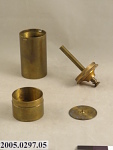Baking Cylinder
- Image
- View Full Item
- Created Date
- early 1900s
- Description
This small brass instrument measures the gluten strength of a sample of flour. John Alfonso Wesener (1865-1926), a Chicago physician, pharmaceutical chemist, and founder (in 1894) of the Columbus Medical Laboratory, introduced the form in 1901. In operation, one mixes and kneads a simple bread dough (flour, water, and yeast), puts a small amount in the cylinder, inserts the piston, and screws on the top. The cylinder is then put into an incubator until the expansion of the dough causes the cylinder to rise to a certain mark; it then moves it to an oven until it is done. From the overall rise of the piston one can calculate the size of a one pound loaf made from that flour.
Ref: Central Scientific, Catalog M. Physical and Chemical Apparatus (Chicago, 1914), p. 367; and Catalog C (Chicago, 1922), p. 241.
"Bread Baking As A Science," Chicago Tribune (Jan. 12, 1901), p. 8.
Currently not on view
- Creator
Central Scientific Company
- Partner
- Smithsonian Institution
- Contributing Institution
- National Museum of American History
- Collection
- Medicine and Science: Physical Sciences
- Subjects
- Central Scientific Company
- Rights
- Colorado State University
- Chicago citation style
- Central Scientific Company. Baking Cylinder. early 1900s. Retrieved from the Digital Public Library of America, http://collections.si.edu/search/results.htm?q=record_ID=nmah_1301377&repo=DPLA. (Accessed January 21, 2025.)
- APA citation style
- Central Scientific Company, (early 1900s) Baking Cylinder. Retrieved from the Digital Public Library of America, http://collections.si.edu/search/results.htm?q=record_ID=nmah_1301377&repo=DPLA
- MLA citation style
- Central Scientific Company. Retrieved from the Digital Public Library of America <http://collections.si.edu/search/results.htm?q=record_ID=nmah_1301377&repo=DPLA>.
